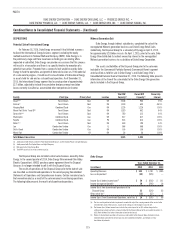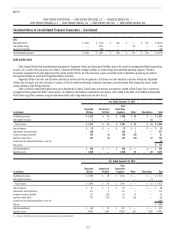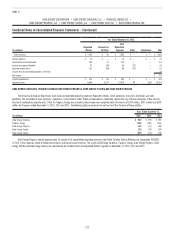Duke Energy 2015 Annual Report Download - page 131
Download and view the complete annual report
Please find page 131 of the 2015 Duke Energy annual report below. You can navigate through the pages in the report by either clicking on the pages listed below, or by using the keyword search tool below to find specific information within the annual report.
111
PART II
DUKE ENERGY CORPORATION • DUKE ENERGY CAROLINAS, LLC • PROGRESS ENERGY, INC. •
DUKE ENERGY PROGRESS, LLC. • DUKE ENERGY FLORIDA, LLC. • DUKE ENERGY OHIO, INC. • DUKE ENERGY INDIANA, INC.
Combined Notes to Consolidated Financial Statements – (Continued)
December 31,
(in millions) 2015 2014
Duke Energy $ 748 $ 827
Duke Energy Carolinas 283 295
Progress Energy 172 217
Duke Energy Progress 102 135
Duke Energy Florida 70 82
Duke Energy Ohio 3—
Duke Energy Indiana 31 27
Additionally, Duke Energy Ohio and Duke Energy Indiana sell, on a
revolving basis, nearly all of their retail accounts receivable, including
receivables for unbilled revenues, to an affiliate, Cinergy Receivables Company,
LLC (CRC) and account for the transfers of receivables as sales. Accordingly,
the receivables sold are not reflected on the Consolidated Balance Sheets of
Duke Energy Ohio and Duke Energy Indiana. See Note 17 for further information.
These receivables for unbilled revenues are shown in the table below.
December 31,
(in millions) 2015 2014
Duke Energy Ohio $71 $79
Duke Energy Indiana 97 112
Allowance for Doubtful Accounts
Allowances for doubtful accounts are presented in the following table.
December 31,
(in millions) 2015 2014 2013
Allowance for Doubtful Accounts
Duke Energy $ 18 $ 17 $ 30
Duke Energy Carolinas 33 3
Progress Energy 68 14
Duke Energy Progress 47 10
Duke Energy Florida 22 4
Duke Energy Ohio 22 2
Duke Energy Indiana 11 1
Allowance for Doubtful Accounts – VIEs
Duke Energy $ 53 $ 51 $ 43
Duke Energy Carolinas 76 6
Progress Energy 88 —
Duke Energy Progress 55 —
Duke Energy Florida 33 —
Derivatives and Hedging
Derivative and non-derivative instruments may be used in connection
with commodity price, interest rate and foreign currency risk management
activities, including swaps, futures, forwards and options. All derivative
instruments, except those that qualify for the normal purchase/normal sale
(NPNS) exception, are recorded on the Consolidated Balance Sheets at fair
value. Qualifying derivative instruments may be designated as either cash
flow hedges or fair value hedges. Other derivative instruments (undesignated
contracts) either have not been designated or do not qualify as hedges. The
effective portion of the change in the fair value of cash flow hedges is recorded
in AOCI. The effective portion of the change in the fair value of a fair value hedge
is offset in net income by changes in the hedged item. For activity subject to
regulatory accounting, gains and losses on derivative contracts are reflected as
regulatory assets or liabilities and not as other comprehensive income or current
period income. As a result, changes in fair value of these derivatives have no
immediate earnings impact.
Formal documentation, including transaction type and risk management
strategy, is maintained for all contracts accounted for as a hedge. At inception
and at least every three months thereafter, the hedge contract is assessed to
see if it is highly effective in offsetting changes in cash flows or fair values of
hedged items.
See Note 14 for further information.
Captive Insurance Reserves
Duke Energy has captive insurance subsidiaries that provide coverage,
on an indemnity basis, to the Subsidiary Registrants as well as certain third
parties, on a limited basis, for various business risks and losses, such as
property, workers’ compensation and general liability. Liabilities include
provisions for estimated losses incurred but not yet reported (IBNR), as well as
estimated provisions for known claims. IBNR reserve estimates are primarily
based upon historical loss experience, industry data and other actuarial
assumptions. Reserve estimates are adjusted in future periods as actual losses
differ from experience.
Duke Energy, through its captive insurance entities, also has reinsurance
coverage with third parties for certain losses above a per occurrence and/or
aggregate retention. Receivables for reinsurance coverage are recognized when
realization is deemed probable.
Unamortized Debt Premium, Discount and Expense
Premiums, discounts and expenses incurred with the issuance of
outstanding long-term debt are amortized over the term of the debt issue. Call
premiums and unamortized expenses associated with refinancing higher-cost
debt obligations in the regulated operations are amortized. Amortization expense
is recorded as Interest Expense in the Consolidated Statements of Operations
and is reflected as Depreciation, amortization and accretion within Net cash
provided by operating activities on the Consolidated Statements of Cash Flows.
During 2015, Duke Energy retrospectively adopted revised accounting
guidance related to the presentation of debt issuance costs. Unamortized debt
issuance cost are presented as a reduction of the debt amount and included in
Long-Term Debt on the Consolidated Balance Sheets presented. See discussion
of New Accounting Standards below for further information.
Loss Contingencies and Environmental Liabilities
Contingent losses are recorded when it is probable a loss has occurred
and can be reasonably estimated. When a range of the probable loss exists and
no amount within the range is a better estimate than any other amount, the
minimum amount in the range is recorded. Unless otherwise required by GAAP,
legal fees are expensed as incurred.
Environmental liabilities are recorded on an undiscounted basis when
environmental remediation or other liabilities become probable and can be
reasonably estimated. Environmental expenditures related to past operations
that do not generate current or future revenues are expensed. Environmental
expenditures related to operations that generate current or future revenues are
expensed or capitalized, as appropriate. Certain environmental expenditures
receive regulatory accounting treatment and are recorded as regulatory assets.
See Notes 4 and 5 for further information.
























